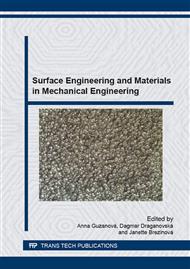[1]
L. Berglund, R.M. Rowell, Handbook of wood chemistry and wood composites, CRC Press, Boca Raton, (2005).
Google Scholar
[2]
W. Darmawan, H. Usuki, J. Quesada, R. Marchal, Clearance wear and normal force of TiN-coated P30 in cutting hardboards and wood-chip cement boards, Holz Roh Werkst 66 (2008) 89–97.
DOI: 10.1007/s00107-007-0213-5
Google Scholar
[3]
H.A. Stewart, High-temperature halogenation of tungsten carbide cobalt tool material when machining medium density fiberboard, Forest Prod. J. 42 (1992) 27–31.
Google Scholar
[4]
J.Y. Sheikh-Ahmad, J.A. Bailey, High-temperature wear of cemented tungsten carbide tools while machining particleboard and fiberboard, J. Wood Sci. 45 (1999) 445–455.
DOI: 10.1007/bf00538952
Google Scholar
[5]
R. Bridges, A quantitative study of some factors affecting the abrasiveness of particle board, Forest Prod. J. 11 (1971) 39–41.
Google Scholar
[6]
B. Porankiewicz, Variation in composition of micro-grain cemented carbide and its impact on cutting edge wear during particleboard machining, Proc. 13th IWMS, Vancouver, Canada, 1997, p.791–799.
Google Scholar
[7]
B. Porankiewicz, A, Gronlund, Tool wear–influencing factors, Proc. 10th IWMS, UC, Berkeley, USA, 1991, p.220–229.
Google Scholar
[8]
B. Porankiewicz, A method to evaluate the chemical properties of particleboard to anticipate and minimize cutting tool wear, Wood Sci. Technol. 37 (2003) 47–58.
DOI: 10.1007/s00226-003-0166-8
Google Scholar
[9]
A.J. Sparks, V. Taylor, Chip board machinability, Part 1: The effect of cut on cutter wear, Furniture Industry Research Association, No. 928/ 271/81, (1981).
Google Scholar
[10]
B. Porankiewicz, Investigation of chemical wear of cemented carbide cutting edges by processing board materials, Project Report No. MR/ USDA-95-219, 1998, p.32.
Google Scholar
[11]
T.M. Maloney, Modern particleboard and dry-process fiberboard manufacturing, Miller Freeman, San Francisco, (1993).
Google Scholar
[12]
O. Suchsland, G.E. Woodson, Fiberboard manufacturing practices in the United States, Agriculture Handbook, No. 640, United States Department of Agriculture, (1986).
Google Scholar
[13]
M. W Kelly, Critical literature review of relationships between processing parameters and physical properties of particleboard, Gen. Tech. Rep. FPL-10, Forest Products Laboratory, Forest Service, US, Department of Agriculture, USA, 1977, p.66.
Google Scholar
[14]
S. Chen, X. Liu, L. Fang, R. Wellwood, Digital X-ray analysis of density distribution characteristics of wood-based panels, Wood Sci. Technol. 44 (2010) 85–93.
DOI: 10.1007/s00226-009-0256-3
Google Scholar


